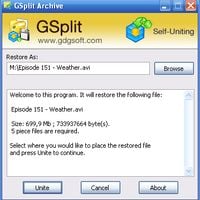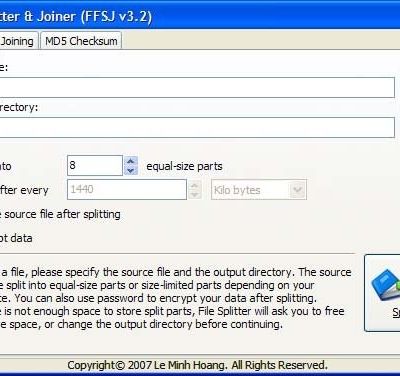

Install Dropbox on your computer (as opposed to simply using it from your web browser). Where and how do I upload to someplace on the internet people can see?” I know the next question: “You have your own website. (This can be very much appreciated on slow or metered connections.) Upload where?
GSPLIT ALTERNATIVES DOWNLOAD
Even better, they get to choose whether to download it at all. Most importantly, it’s much smaller than actually including the document itself, not likely to trip any attachment-related filters, and works with any email service or program.Īll your recipient needs to do is click on the link to download the file. If the file is larger, or there are more files making the message too big, the send will fail.Ī different approach is to upload the document to a location accessible on the web, and then send a link: Sending a link to a file using. In this example, my “large” file isn’t that large - only three megabytes - and will happily send that message. Composing an email with an attachment in. Your first reaction would simply be to attach that file to an email and hit Send. pdf, that’s somewhat large, and I want to email it to you. Say I have a file, InternetSafety-v5-Free. The alternative is very simple: upload the file somewhere and send a link.

The ability to attach files is a convenience, but the way email works just doesn’t make it an efficient way to move large files. It’s not something we have control over, and it contributes to the reason large emails are frowned upon, and occasionally even prohibited, by most email providers.Įmail was never really meant as a way to transfer large files. An email message can travel across many servers and machines along the way. There are several intermediaries responsible for getting messages from point A to point B.

In reality, that’s not how it works at all. We think of email as point-to-point: we send, they receive.
GSPLIT ALTERNATIVES HOW TO
In “ How to Get Email with Attachments Delivered,” I discussed some of the many problems with emailing large attachments. Thus if you have a nine- megabyte file, you may find that it adds 12 megabytes to the size of your email message. Because of the way email encodes attachments, the result is approximately 20-40% bigger than the original. In addition, the size of an attached file isn’t the size used in the calculation. If you have several smaller attachments that add up to something over the limit, the result is defined as large. It’s important to note that this is not the size of an attachment, but rather the size of the entire email, including its body and all attachments. Different email services have different definitions of what they allow or disallow. There’s no real definition of what it means for a file to be large. By far the best alternative is to place the file in a cloud service like Dropbox, OneDrive, Google Drive, or others, and then include a link to the file in your email. Exactly what is a “large” email varies depending on your email provider, but most have size limits on what you can send.


 0 kommentar(er)
0 kommentar(er)
